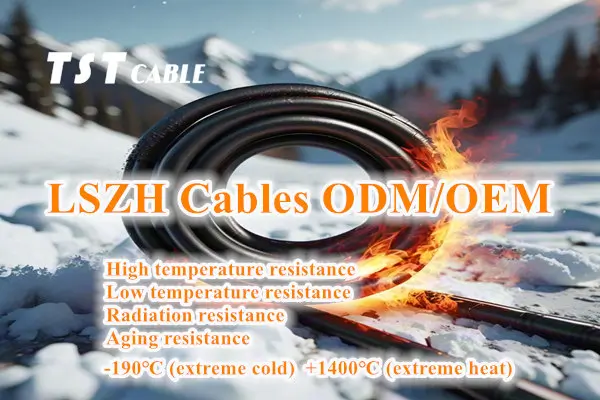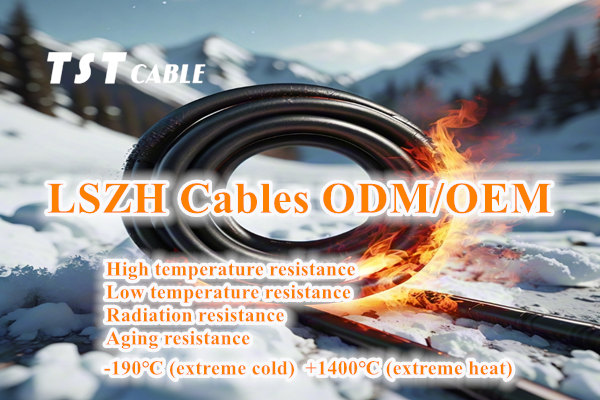
XLPE flat cable
Flat cable is widely used in a variety of application scenarios due to its compact design and easy wiring. When flat cable is combined with cross-linked polyethylene (XLPE) material, its performance is further improved, suitable for occasions requiring high insulation performance and reliability.
XLPE flat cable features and advantages
1. Compact design: Flat cable saves space and is easy to wire and install.
2. High insulation performance: XLPE material provides excellent electrical insulation performance.
3. Heat resistance: Suitable for high temperature environment and maintain stable working performance.
4. Flexibility: Easy to bend and lay, suitable for complex wiring needs.
5. Durability: Has a long service life and reduces maintenance and replacement frequency.
6. Safety: Reduces the risk of electrical accidents caused by insulation damage.
XLPE flat cable industry application
1. Internal wiring of electronic equipment: used for internal connection of office equipment such as computers and printers.
2. Home appliance manufacturing industry: Suitable for internal wiring of home appliances such as refrigerators and washing machines.
3. Industrial automation: used as signal transmission lines in automated production lines and control systems.
4. Medical equipment: used for precision wiring inside medical instruments.
5. Transportation: used as power lines or signal lines inside vehicles such as cars and ships.
Technical data of XLPE flat cable:
Tinned, annealed, stranded or solid copper conductor, surface coating.
Rated temperature: 105℃.
Rated voltage: 300V.
Passed UL&CUL, horizontal burning test.
Internal wiring of electrical appliances.
| XLPE UL cable | Arbitrary Waveform Generator | Conductor | asphalt | core | Insulation thickness | Comprehensive diameter gauge | Conductor20℃ resistance |
| Attributes | |||||||
| None/mm | mm | NO | mm | mm | Ω/KM | ||
| UL4478(绞线) | 26 | 7/0.16 | 2.54 | 2P-40P | 0.23 | 1.05 | 150.00 |
| 28 | 7/0.127 | 2.54 | 9 | 0.23 | 0.9×11.43 | 150.00 | |
| 28 | 7/0.127 | 10 | 0.9×12.7 | ||||
| 28 | 7/0.127 | 14 | 0.9×17.78 | ||||
| 28 | 7/0.127 | 15 | 0.9×19.05 | ||||
| 28 | 7/0.127 | 16 | 0.9×20.32 | ||||
| 28 | 7/0.127 | 20 | 0.9×25.4 | ||||
| 28 | 7/0.127 | 25 | 0.9×31.75 | ||||
| 28 | 7/0.127 | 26 | 0.9×33.02 | ||||
| 28 | 7/0.127 | 30 | 0.9×38.1 | ||||
| 28 | 7/0.127 | 34 | 0.9×43.18 | ||||
| 28 | 7/0.127 | 36 | 0.9×45.72 | ||||
| 28 | 7/0.127 | 40 | 0.9×50.8 | ||||
| 28 | 7/0.127 | 50 | 0.9×63.5 | ||||
| 28 | 7/0.127 | 60 | 0.9×76.2 |
[Compact design, excellent performance – XLPE flat cable]
In the face of increasingly complex internal wiring requirements for electrical equipment, we present to you the latest XLPE flat cable solution. Combining a compact design with the excellent insulating properties of cross-linked polyethylene (XLPE), this cable not only saves space, but also maintains stable operation in high-temperature environments. Its excellent flexibility and durability make installation easier and faster, while greatly extending its service life. Whether it is industrial automation production lines or internal wiring of medical equipment, XLPE flat cable is your trustworthy choice. Let our products add safety to your equipment and jointly create a more efficient and reliable working environment.
What is the difference between flat cable and round cable?
There are significant differences between flat cables and round cables (round cables) in terms of structure, application, performance, etc. Understanding these differences can help you choose the most appropriate product for different application scenarios. Here are the main differences between flat cables and round cables:
Differences in structure between flat cables and round cables
flat cable
·Appearance: As the name implies, flat cables have a flat appearance and are usually composed of multiple conductors arranged in parallel.
·Conductor arrangement: Conductors are arranged parallel to each other and each conductor is individually insulated.
·Sheath: There is usually a thin, wide outer sheath that wraps all the conductors together.
round cable
·Shape: Round cable is round in shape, with multiple conductors twisted together to form a circular cross-section.
·Conductor Arrangement: Conductors are twisted or braided together to form a densely packed structure in the center.
·Sheath: The sheath of round cables is usually thick and completely surrounds all conductors.
Application differences between flat cables and round cables
flat cable
·Suitable occasions: Mainly used in places where space needs to be saved and wiring is facilitated.
·Application scenarios: Commonly used in computer internal wiring, home appliances, automobile internal wiring, printers and other office equipment, home entertainment systems, etc.
·Advantages: easy wiring, small space occupation, suitable for installation in small spaces.
round cable
·Suitable occasions: Suitable for occasions requiring high mechanical strength and flexibility.
·Application scenarios: Widely used in power transmission, industrial control, building wiring, communication networks and other fields.
·Advantages: high mechanical strength, bending resistance, suitable for use in complex environments.
Performance differences between flat cables and round cables
flat cable
·Electrical Performance: In some cases, flat cables may have lower inductance because the conductors are fixed and closer together.
·Mechanical properties: Compared with round cables, flat cables have lower mechanical strength and are easily crushed or damaged.
·Heat dissipation performance: Flat cables may have better heat dissipation performance due to their larger surface area.
round cable
·Electrical performance: The electrical performance of round cables is generally more balanced, especially in terms of high-frequency signal transmission.
·Mechanical properties: Round cables have better mechanical strength and tensile properties, and are suitable for occasions with frequent movement or bending.
·Heat dissipation performance: The heat dissipation performance of round cables is relatively low, but due to its tighter structure, the heat dissipation effect is not as obvious as that of flat cables.
Should you choose flat or round cables?
The choice between flat or round cables mainly depends on the specific application requirements:
·Flat cable may be a better choice if you need to save space, simplify wiring, and have a more stationary environment.
·If you need a cable with higher mechanical strength, better flexibility, and adaptability to complex and changing environments, you should choose round cables.
flat cable
[Simplified wiring, do whatever you want – flat cable]
How to achieve efficient wiring in a space where every inch of land is at a premium? Choosing our flat cables can not only easily solve the wiring problem in small spaces, but also ensure the stability of signal transmission. Whether it is the internal connection of home appliances or the linkage between office equipment, TST CABLES flat cables allow you to enjoy a more convenient and beautiful wiring experience with its unique flat design.
round cable
[Tough and durable, not afraid of challenges – round cable]
Facing harsh industrial environments, you need a cable that can withstand repeated bending and pulling. TST CABLES’ round cables are made of high-strength materials and carefully designed to ensure excellent performance under complex working conditions. Whether it is power transmission or signal conduction, round cables can provide you with reliable solutions to keep your system running worry-free.
Also available in:
English




